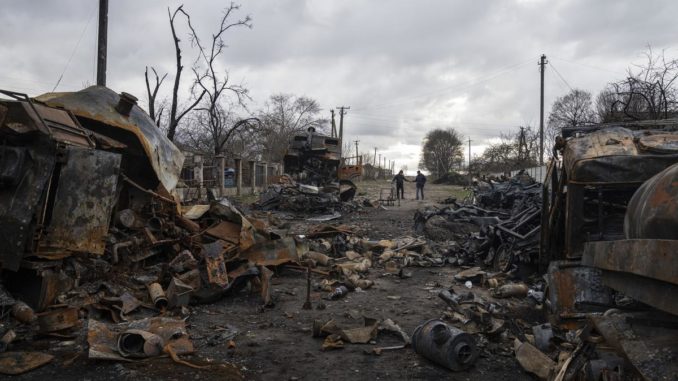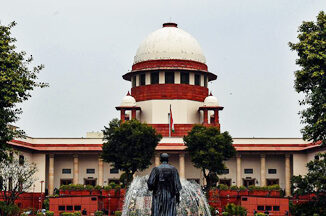

In 2003, despite a growing partnership with the U.S. that was finally turning a corner after the nuclear tests, the Indian government brought a resolution to Parliament that “deplored” the actions of the coalition led by the U.S. for its war on a sovereign Iraq, calling the invasion “unacceptable”. But then External Affairs Minister Yashwant Sinha stood up to speak during the debate on the resolution passed unanimously, and noted that despite India’s differences with the U.S. on the war, the Government would continue to develop bilateral relations. It should have been possible for the government of the day to express its opposition to Russian actions in Ukraine similarly, while maintaining an independent position on unilateral sanctions.
It is possible for the Government to express its criticism while maintaining an independent stand on unilateral sanctions. Just four years ago, in June 2018, then United States President Donald Trump sent his Ambassador to the United Nations, Nikki Haley, on a sensitive mission to New Delhi. Ms. Haley, who was to meet Prime Minister Narendra Modi to convince the Government to drop its oil imports from Iran or face U.S. sanctions, and said that India must “rethink its ties”, was probably chosen because she was a diplomat and also an Indian-American which had a certain appeal in India. A day later, India’s petroleum ministry asked refiners to cut imports from Iran. Within a few months, when the American deadline expired, the Government announced that it had “zeroed out” its imports of oil from Iran, once India’s preferred choice and its third biggest supplier of crude.
‘Appeals’ and India’s reaction
Now, in 2022, the U.S. pressure on India to cut its oil imports from Russia has been much less subtle. The appeal to “zero out” oil purchases from Russia, and not accelerate them, has come from the highest quarters: these include U.S. President Joe Biden to Mr. Modi during a virtual summit;U.S. Secretary of State Antony Blinken during the “2+2” ministerial meeting in Washington last week, and from another Indian-American emissary, Deputy National Security Adviser for International Economics Daleep Singh, who, while he was on a visit to Delhi, spoke of “consequences” for creating payment mechanisms around sanctions against Russia. The pressure is likely to increase in the coming weeks, with more engagements planned by Mr. Modi with European leaders — the British Prime Minister Boris Johnson will arrive in India this week, and Mr. Modi is expected to travel to Germany and France for bilateral meetings and to Denmark for a summit with Nordic countries.
Thus far, nearly two months into Russia’s war with Ukraine, New Delhi’s position has been to push back: External Affairs Minister S. Jaishankar said in February that India does not recognize unilateral sanctions (only the ones mandated by the United Nations), followed by some tough talking in Washington last week. This includes the fact that after 12 occasions of votes at the UN, India continues to abstain on resolutions critical of Russia’s invasion and the daily bombardment of civilians. Despite talks with leaders from the U.S., Japan and Australia, each of whom criticized Russia in their summit remarks, India’s Ministry of External Affairs has not allowed any direct mention of Russia in the respective joint statements. In March and April, India has bought more Russian oil, at a discount, than it did in all of 2021, and is now accelerating coal imports as well. While deliveries of the Russian S-400 missile defense system may be delayed by the war, New Delhi is not putting its defense deals with Moscow on hold. Russian bank officials have held meetings with the Reserve Bank of India in Mumbai for technical talks on the rupee-rouble payment mechanism to be used for purchases that circumvent sanctions.
Sustainability of stand
So, what explains the Government’s refusal to bow to combined western pressure on the issue of India’s Russian engagement so far, when it gave in to far less pressure on dealing with Iran? And can New Delhi’s position be sustained much longer? While most analysis of India’s stance deals with its past relationship with Russia, (this includes the Soviet Union), the truth may lie in the Modi government’s perceptions of its future challenges: from its defense and energy procurements to global economic trends, to its continental border challenges, especially with China, and the growing focus by western countries on human rights issues in India. For example, India’s defense hardware dependency on Russia ranges around 60%, while dependency on spare parts is close to 85%. These could be offset with more purchases from the U.S. and the procurement of spares from the Commonwealth of Independent State countries that produced Soviet weapons. What will be harder to replace are defense purchases involving the transfer of technology, and export capabilities such as the BrahMos missile (short for Brahmaputra-Moskva), as the Government seeks more domestic production.
Similarly, while India’s energy dependence on Russia has been pegged at less than 2%, and it is unlikely to substantially increase its intake on the “heavy” Ural variety due to its high sulphur content, it is worth remembering that Indian oil public sector units have invested $16 billion in Russian oil and gas fields in eastern Russia, with stakes in Sakhalin-1, Vankor and Taas-Yuryakh . In 2017, Russia fulfilled a long-held dream dating back to Tsarist times to buy a warm water port, when Rosneft acquired a stake in the Vadinar refinery situated strategically on the Gujarat coast as part of a deal for a 49% stake in Essar Oil (this was a deal that Mr. Modi and Russian President Vladimir Putin had themselves promoted at a summit). In renewable energy too, while India has signed civil nuclear deals with a number of countries, including the U.S. and France, the only foreign nuclear power plants that actually exist are those built by Russia (Kudankulam in Tamil Nadu).
Above all, any serious future analysis of the conflict would question the long-term sustainability of the sanctions imposed by the western bloc, their effect on the Russian economy, and whether a sizeable number of important global economies will join the sanctions regime. If only about 30 to 40 countries have joined the sanctions trail, while India, China and much of South America and Africa stay out (as is the situation now), then it stands to reason that India does not benefit by restricting itself to only one side of the “dollar vs non-dollar” economic system and will seek to straddle both.
Comfort in groupings
India’s strategic future is also inextricably linked with Russia. The Napoleonic adage, “If you know a country’s geography, you can understand and predict its foreign policy”, could not hold truer for India’s continental predicament with its primary threats on its northern frontier from China and Pakistan, and a resultant need to have Russia onside. In the past two years, as Chinese troops have transgressed and occupied Indian territory, it is Moscow that has stepped in to provide venues and facilitate talks that have resulted in partial disengagement. Russian Foreign Minister Sergei Lavrov’s visit to Delhi this month — he arrived directly from China, and one that closely followed the trip by Chinese Foreign Minister Wang Yi to India (and also where both officials stressed the importance of regional cooperation) on the one hand and last week’s meeting of the Brazil-Russia-India-China-South Africa Sherpas on the other, are pointers. They indicate that the Modi government still finds comfort in groupings such as BRICS, RIC (Russia-India-China) and Shanghai Cooperation Organisation (SCO), despite all the developments so far.
As has been oft-repeated, Russia’s consistent support as a P-5 member of the UN Security Council is important, albeit not irreplaceable, but its support at other multilateral institutions such as the Financial Action Task Force (FATF) and the Nuclear Suppliers Group makes it that much more valuable. These factors are reinforced by the Modi-Putin bonhomie. Apart from visits to Brussels to meet Mr. Biden and Beijing to meet Chinese President Xi Jinping, Mr. Putin has made an exception only for Delhi, meeting Mr. Modi last December. The two leaders are in regular telephonic contact, and unlike the West, Mr. Putin has not (even once) raised concerns over the “backsliding of democracy” or “human rights violations” in the manner the European Union and the U.S. have — these include the Citizenship (Amendment) Act, the Jammu and Kashmir reorganization, or the treatment of minorities, the media and non-governmental organizations.
If these are the “pull factors” that keep New Delhi firmly anchored to Moscow, the absence of any “push factors” is another reason for this situation. While in 2017, Mr. Trump may have seemed irrational enough to sanction a strategic partner such as India over Iran, a Biden administration as well as European countries seem far less likely to do so. As a result, South Block’s expectation is that riding out this current period will be easier, apart from a few awkward conversations at the leadership levels.
In refusing to entertain western sanctions, and even building payment structures to circumvent them, the Government has invoked India’s firmly held principles of non-alignment and strategic autonomy. They mirror decisions of the past like when the A.B. Vajpayee government decided to conduct nuclear tests and face sanctions in 1998, and the Manmohan Singh government refused to bend to U.S. pressure on Iran oil sanctions, despite a visit by the U.S. Secretary of State, Hillary Clinton, in 2012.
Expression without fear
What the Government fails to explain, however, is why any of these reasons prevent it from criticizing Russia for what is quite obviously a brutal invasion by one country on another. In 2003, despite a growing partnership with the U.S. that was finally turning a corner after the nuclear tests, the Indian government brought a resolution to Parliament that “deplored” the actions of the coalition led by the U.S. for its war on a sovereign Iraq, calling the invasion “unacceptable”. But then External Affairs Minister Yashwant Sinha stood up to speak during the debate on the resolution passed unanimously and noted that despite India’s differences with the U.S. on the war, the Government would continue to develop bilateral relations.
It should have been possible for the government of the day to express its opposition to Russian actions in Ukraine similarly, while maintaining an independent position on unilateral sanctions. The Government could look no further at the explanation on neutrality that Prime Minister Jawaharlal Nehru gave during a speech in the U.S. in 1949, a few years before the Bandung Conference that led India to the Non-aligned Movement — “We are neither blind to reality nor do we propose to acquiesce in any challenge to man’s freedom from whatever quarter it may come. Where freedom is menaced or justice threatened or where aggression takes place, we cannot and shall not be neutral.” The assertion of strategic autonomy cannot carry credibility unless it is expressed without fear or favor of the consequences.
(Source: The Hindu. The author can be reached at suhasini.h@thehindu.co.in)





Be the first to comment